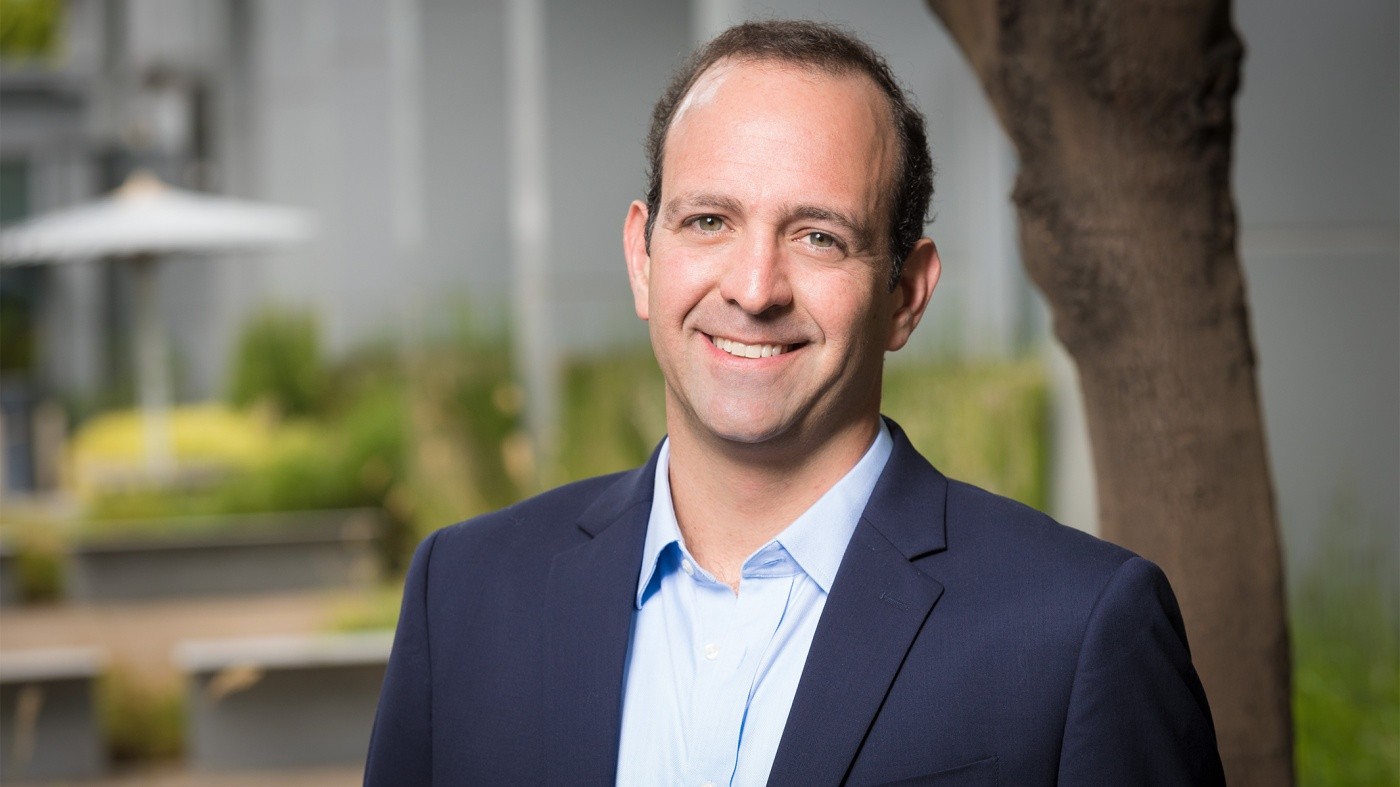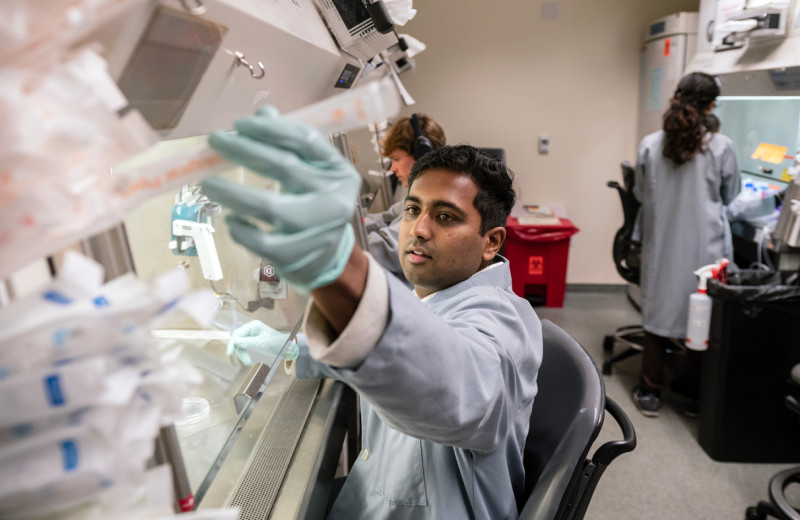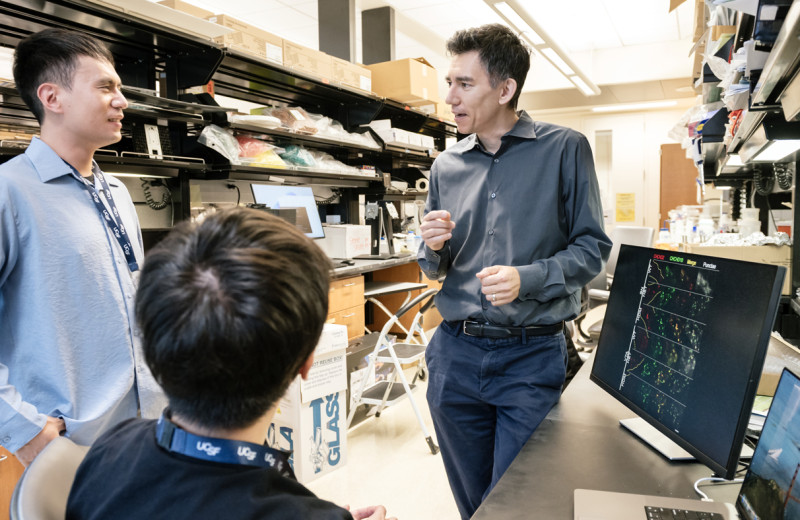Gladstone NOW: The Campaign Join Us on the Journey✕

Leor Weinberger and his team discovered a noisy step in gene expression.
You can think of a cell in your body like a miniature factory, creating a final product called proteins, which carry out various tasks and functions. In this cellular factory, genes control the series of sequential steps needed to create proteins, much like an assembly line moving a product along to completion. This process is known as gene expression.
Even when two cells are genetically identical and in the same environment, the amount of each protein they express can be very different. This variability—or noise—has been shown to play a role in viral infection, antibiotic resistance, and drug resistance in cancer cells.
A group of scientists led by Leor S. Weinberger, PhD, the William and Ute Bowes Distinguished Professor and director of the Center for Cell Circuitry at Gladstone Institutes, are studying the factors within a cell that can influence noise.
“We are trying to determine whether differences in one step along the assembly line influences the final amount of proteins produced more than other steps,” said Weinberger, who is also a professor of pharmaceutical chemistry at UC San Francisco.
Using a combination of computational and experimental methods, the team examined how a variety of cells produce different proteins, and measured noise for each step along the production process. They discovered that for 85 percent of genes, the noise magnitude is higher in the last step as compared to the first step.
“When thinking about gene expression, we used to be unsure how each step contributed to the final outcome,” said Maike Hansen, PhD, postdoctoral scholar in Weinberger’s laboratory and first author of the new study. “But we discovered that one step works very differently than we thought. It’s as if you always thought the production process was very streamlined, but then realized it’s actually much noisier.”
Their findings, published in the scientific journal Cell Systems, indicate that the scientific community may have been misinterpreting an important step in gene expression for a long time. This could impact work by synthetic and systems biologists, as well as cell biologists.
The group’s next step will be to investigate what mechanisms the cells employ to control noise.
“We’ve discovered an important step that increases cell-to-cell differences. These differences contribute to difficulties in treating various diseases.” said Weinberger. “Once we understand the mechanisms involved, we can start to exploit them for therapeutic targets.”
About the Study
Other contributors to this study include Ravi V. Desai from Gladstone and Michael L. Simpson from Oak Ridge National Laboratory. The research was supported by the Bowes Distinguished Professorship, the Alfred P. Sloan Research Fellowship, the National Institutes of Health (through the NIH Director’s New Innovator Award and the Pioneer Award programs), and the Netherlands Organization of Scientific Research.
For Media
Julie Langelier
Associate Director, Communications
415.734.5000
Email
About Gladstone Institutes
Gladstone Institutes is an independent, nonprofit life science research organization that uses visionary science and technology to overcome disease. Established in 1979, it is located in the epicenter of biomedical and technological innovation, in the Mission Bay neighborhood of San Francisco. Gladstone has created a research model that disrupts how science is done, funds big ideas, and attracts the brightest minds.
Support Discovery Science
Your gift to Gladstone will allow our researchers to pursue high-quality science, focus on disease, and train the next generation of scientific thought leaders.
Six Gladstone Scientists Named Among World’s Most Highly Cited Researchers
Six Gladstone Scientists Named Among World’s Most Highly Cited Researchers
The featured scientists include global leaders in gene editing, data science, and immunology.
Awards News Release Corces Lab Doudna Lab Marson Lab Pollard Lab Ye LabThe Genome Editing Playbook Is Different in Neurons
The Genome Editing Playbook Is Different in Neurons
The striking findings of a new study could influence how gene therapies are designed for many genetic diseases.
News Release Research (Publication) Neurological Disease Conklin Lab Doudna Lab CRISPR/Gene EditingEvidence Builds for Disrupted Mitochondria as Cause of Parkinson’s
Evidence Builds for Disrupted Mitochondria as Cause of Parkinson’s
A new study from Gladstone Institutes strengthens the links between energy breakdown in cells and the onset of Parkinson’s, potentially illuminating new paths for treatment.
News Release Research (Publication) Parkinson’s Disease Neurological Disease Nakamura Lab



